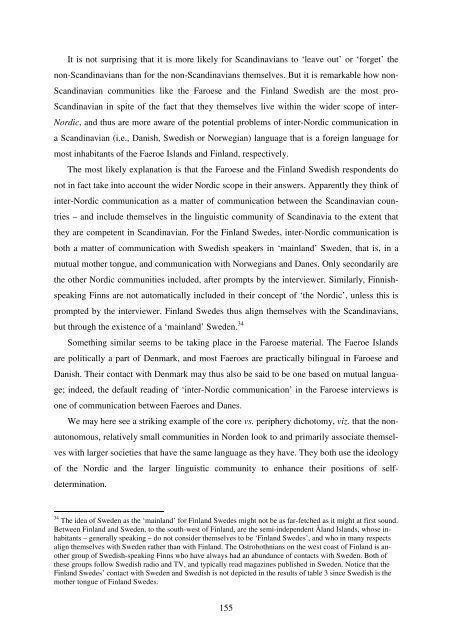Hør dog hvad de siger - Note-to-Self: Trials & Errors
Hør dog hvad de siger - Note-to-Self: Trials & Errors
Hør dog hvad de siger - Note-to-Self: Trials & Errors
You also want an ePaper? Increase the reach of your titles
YUMPU automatically turns print PDFs into web optimized ePapers that Google loves.
It is not surprising that it is more likely for Scandinavians <strong>to</strong> ‘leave out’ or ‘forget’ the<br />
non-Scandinavians than for the non-Scandinavians themselves. But it is remarkable how non-<br />
Scandinavian communities like the Faroese and the Finland Swedish are the most pro-<br />
Scandinavian in spite of the fact that they themselves live within the wi<strong>de</strong>r scope of inter-<br />
Nordic, and thus are more aware of the potential problems of inter-Nordic communication in<br />
a Scandinavian (i.e., Danish, Swedish or Norwegian) language that is a foreign language for<br />
most inhabitants of the Faeroe Islands and Finland, respectively.<br />
The most likely explanation is that the Faroese and the Finland Swedish respon<strong>de</strong>nts do<br />
not in fact take in<strong>to</strong> account the wi<strong>de</strong>r Nordic scope in their answers. Apparently they think of<br />
inter-Nordic communication as a matter of communication between the Scandinavian coun-<br />
tries – and inclu<strong>de</strong> themselves in the linguistic community of Scandinavia <strong>to</strong> the extent that<br />
they are competent in Scandinavian. For the Finland Swe<strong>de</strong>s, inter-Nordic communication is<br />
both a matter of communication with Swedish speakers in ‘mainland’ Swe<strong>de</strong>n, that is, in a<br />
mutual mother <strong>to</strong>ngue, and communication with Norwegians and Danes. Only secondarily are<br />
the other Nordic communities inclu<strong>de</strong>d, after prompts by the interviewer. Similarly, Finnish-<br />
speaking Finns are not au<strong>to</strong>matically inclu<strong>de</strong>d in their concept of ‘the Nordic’, unless this is<br />
prompted by the interviewer. Finland Swe<strong>de</strong>s thus align themselves with the Scandinavians,<br />
but through the existence of a ‘mainland’ Swe<strong>de</strong>n. 34<br />
Something similar seems <strong>to</strong> be taking place in the Faroese material. The Faeroe Islands<br />
are politically a part of Denmark, and most Faeroes are practically bilingual in Faroese and<br />
Danish. Their contact with Denmark may thus also be said <strong>to</strong> be one based on mutual langua-<br />
ge; in<strong>de</strong>ed, the <strong>de</strong>fault reading of ‘inter-Nordic communication’ in the Faroese interviews is<br />
one of communication between Faeroes and Danes.<br />
We may here see a striking example of the core vs. periphery dicho<strong>to</strong>my, viz. that the non-<br />
au<strong>to</strong>nomous, relatively small communities in Nor<strong>de</strong>n look <strong>to</strong> and primarily associate themsel-<br />
ves with larger societies that have the same language as they have. They both use the i<strong>de</strong>ology<br />
of the Nordic and the larger linguistic community <strong>to</strong> enhance their positions of self-<br />
<strong>de</strong>termination.<br />
34 The i<strong>de</strong>a of Swe<strong>de</strong>n as the ‘mainland’ for Finland Swe<strong>de</strong>s might not be as far-fetched as it might at first sound.<br />
Between Finland and Swe<strong>de</strong>n, <strong>to</strong> the south-west of Finland, are the semi-in<strong>de</strong>pen<strong>de</strong>nt Åland Islands, whose inhabitants<br />
– generally speaking – do not consi<strong>de</strong>r themselves <strong>to</strong> be ‘Finland Swe<strong>de</strong>s’, and who in many respects<br />
align themselves with Swe<strong>de</strong>n rather than with Finland. The Ostrobothnians on the west coast of Finland is another<br />
group of Swedish-speaking Finns who have always had an abundance of contacts with Swe<strong>de</strong>n. Both of<br />
these groups follow Swedish radio and TV, and typically read magazines published in Swe<strong>de</strong>n. Notice that the<br />
Finland Swe<strong>de</strong>s’ contact with Swe<strong>de</strong>n and Swedish is not <strong>de</strong>picted in the results of table 3 since Swedish is the<br />
mother <strong>to</strong>ngue of Finland Swe<strong>de</strong>s.<br />
155



